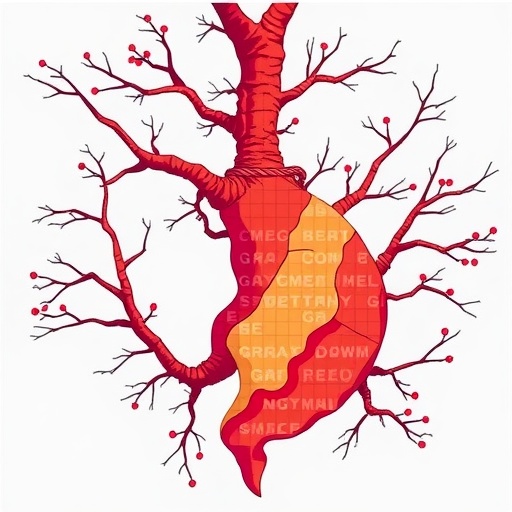In a groundbreaking advance at the crossroads of pediatric medicine and artificial intelligence, recent research has unveiled a sophisticated computational model designed to predict short-term mortality in children suffering from gastrointestinal congenital anomalies. These anomalies, often complex and life-threatening, have long posed significant challenges to clinicians aiming to optimize early interventions and improve survival rates. The innovative approach relies on harnessing the power of a random forest classifier, a robust machine learning algorithm, to analyze multifaceted clinical data and generate accurate prognostic evaluations that were previously unattainable with traditional methods.
The development of predictive models for clinical outcomes in pediatric patients has always been hampered by heterogeneous patient presentations, diverse anomaly types, and the intricate interplay of comorbidities. This study strategically focuses on children with congenital gastrointestinal defects—a group that experiences some of the highest rates of perioperative mortality. The capacity to generate reliable mortality predictions within a short timeframe post-diagnosis could revolutionize treatment strategies, enabling personalized clinical pathways that allocate resources efficiently while minimizing invasive interventions.
Random forest classifiers operate by creating an ensemble of decision trees, each trained on distinct subsets of the data, and synthesizing their outputs to improve classification accuracy. This method excels particularly in handling complex, nonlinear relationships amongst variables, providing resilience against overfitting and accommodating noisy or incomplete data sets—a typical challenge in clinical environments. By integrating this technique into pediatric surgical prognostics, researchers have achieved a significant step towards precision medicine, leveraging computational power to complement clinical judgment.
In constructing the predictive model, the researchers meticulously curated a comprehensive dataset encompassing demographic information, detailed clinical parameters, laboratory findings, and perioperative variables from a diverse cohort of pediatric patients. The inclusion of a wide spectrum of features ensured that the classifier could capture subtle patterns and interactions indicative of mortality risk. Crucially, this data-driven methodology bypassed reliance on preconceived clinical heuristics, which often fail to capture the complexity inherent in congenital gastrointestinal anomalies.
The performance evaluation of the random forest classifier revealed impressive predictive capabilities. Statistical metrics such as sensitivity, specificity, and area under the receiver operating characteristic (ROC) curve illustrated the model’s ability to discern high-risk patients effectively. This level of accuracy surpasses conventional scoring systems used in neonatal and pediatric intensive care units, highlighting the transformative potential of machine learning applications in acute clinical decision-making spaces.
Beyond its predictive prowess, the study addresses the interpretability of the model’s outputs—a critical component in clinical adoption. Techniques like feature importance ranking elucidated which variables most significantly influenced mortality risk, thus aligning the computational insights with clinical relevance. Such transparency fosters trust among healthcare providers and facilitates the integration of AI predictions into multidisciplinary care discussions.
In addition, the temporal dynamics of prediction were explored, enabling clinicians to understand how risk estimates evolve during the critical early phases of treatment. This dynamic modeling supports ongoing patient monitoring and may prompt timely adjustments in therapeutic approaches. The capacity to update risk predictions based on real-time data mirrors the fluid nature of pediatric critical care, where rapid physiological changes necessitate agile responses.
The potential implications of this research span beyond immediate clinical applications. By demonstrating the successful utilization of random forest classifiers in a sensitive and complex patient population, the study paves the way for broader incorporation of AI-driven tools in pediatric surgery and intensive care. This paradigm shift promises not only enhanced patient outcomes but also a redefinition of clinical workflows, where predictive analytics guide strategic planning and resource allocation.
Ethical considerations accompanying the deployment of AI in pediatric care are acknowledged and thoughtfully addressed. Ensuring data privacy, mitigating biases inherent in training datasets, and preserving the clinician’s role as the ultimate decision-maker remain central tenets. The research emphasizes that the model functions as a decision support tool rather than a replacement for human expertise, promoting a symbiotic relationship between technology and practitioners.
Furthermore, the scalability and adaptability of the model to diverse healthcare settings were evaluated. The randomized structure of the classifier supports its application in various institutional contexts, irrespective of specific patient demographics or treatment protocols. This flexibility is vital for translating research findings into widespread clinical practice across different geographic and socioeconomic landscapes.
Collaboration between data scientists, pediatric surgeons, and critical care specialists was instrumental in shaping the study’s design and implementation. This interdisciplinary approach ensured that the model’s development was grounded in clinical realities while leveraging the latest computational methodologies. Such synergy exemplifies the future of medical innovation, where teamwork propels technology from theoretical promise to practical utility.
Importantly, the study not only contributes to mortality prediction but also offers insights into the pathophysiological factors driving poor outcomes in gastrointestinal congenital anomalies. By identifying key predictive features, clinicians gain deeper understanding of disease mechanisms and potential intervention points, informing both surgical strategy and postoperative care.
Looking ahead, the research sets a precedent for integrating longitudinal data streams, including genetic profiles and imaging modalities, which hold the promise of refining prognostication further. The incorporation of multimodal data sources stands to elevate the precision of predictive analytics, facilitating bespoke therapeutic regimens tailored to individual patient profiles.
In sum, this pioneering work on short-term mortality prediction using random forest classifiers represents a confluence of technological innovation and clinical urgency. By unlocking refined risk assessment capabilities for vulnerable pediatric populations, it heralds a new era in which artificial intelligence empowers healthcare providers to save lives through informed, data-driven decisions.
Subject of Research: Short-term mortality prediction in children with gastrointestinal congenital anomalies using machine learning approaches.
Article Title: Short-term mortality prediction in children with gastrointestinal congenital anomalies using a random forest classifier.
Article References:
Serban, A.M. Short-term mortality prediction in children with gastrointestinal congenital anomalies using a random forest classifier. Pediatr Res (2025). https://doi.org/10.1038/s41390-025-04378-2
Image Credits: AI Generated
DOI: https://doi.org/10.1038/s41390-025-04378-2
Tags: advanced computational modelsArtificial Intelligence in Medicinecomplex medical anomaliesgastrointestinal congenital anomaliesheterogeneous patient presentationspediatric clinical outcomesperioperative mortality in childrenpersonalized treatment strategiespredicting child mortalityprognostic evaluation in pediatricsrandom forest machine learningshort-term mortality prediction





